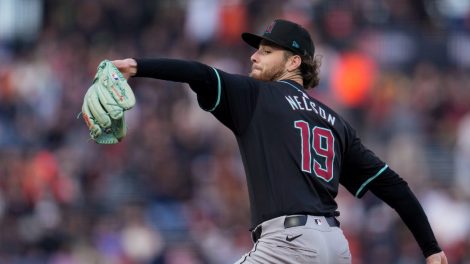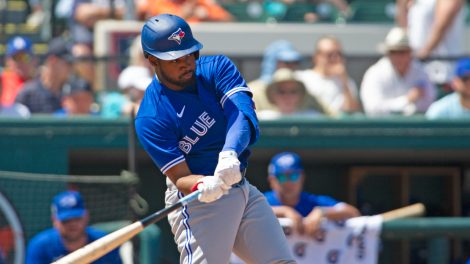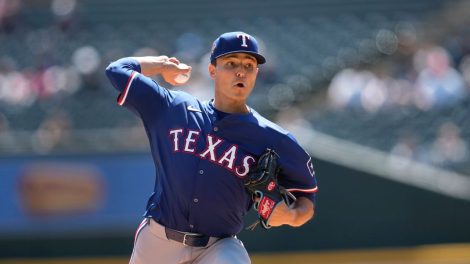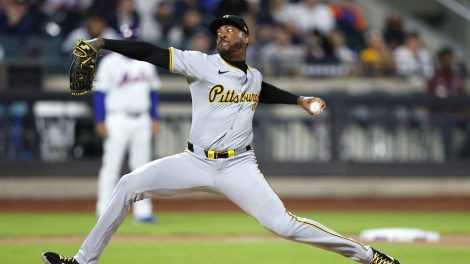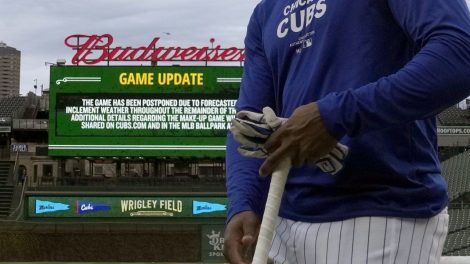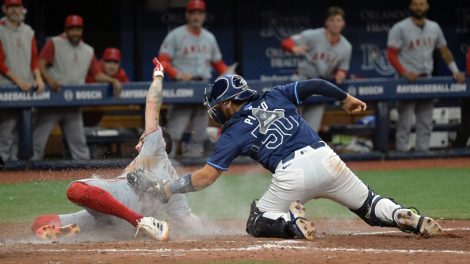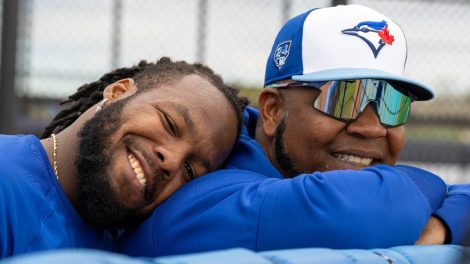Monday, the Toronto Blue Jays will select the contract of the club’s top minor-league prospect — a 21-year-old who plays a premium defensive position and has put up an .894 OPS and 147 wRC+ since making his professional debut three seasons ago. A consensus top-10 prospect in the game who has hit the most doubles (102) of any minor-league player across affiliated baseball since 2017. A confident, exciting athlete who the Blue Jays envision playing every day at shortstop and potentially serving as the club’s leadoff hitter for years to come — one of the most important pieces of Toronto’s ongoing rebuild.
Feels like this should be more of a story, no? But for Bo Bichette’s MLB debut to be shrouded by the complicated departure of Marcus Stroman, a similarly self-assured and thrilling athlete who was once that highly-touted prospect himself, is almost perfectly fitting. It’s exactly how things have gone for Bichette at every step of his nearly four-year journey to the majors.
For one reason or another, and by no fault of his own, Bichette has been perpetually overlooked since he joined the Blue Jays in 2016. He was the organization’s third pick — taken in the second round at No. 66 overall — in that June’s draft, behind T.J. Zeuch and J.B. Woodman. Zeuch, a college right-hander, was brought to Toronto on a press tour and ended up playing full-season ball that year with class-A Lansing. Woodman, another college player ended up in full-season ball as well (he’s now out of baseball entirely). The high-schooler Bichette, meanwhile, was sent off to play rookie ball in the Gulf Coast League, where he had multiple hits in half of his 22 games.
From there, Bichette’s star was dragged into the orbit of once-in-a-generation super-prospect Vladimir Guerrero Jr., who was one of the few minor-leaguers capable of putting up gaudier offensive numbers than him. Guerrero vacuumed attention wherever the duo went while Bichette continued to chug along, quietly notching multi-hit game after multi-hit game. That Bichette actually out-produced his fellow top prospect in 2017, putting up a .988 OPS to Guerrero’s .910 as the pair split their season between mid- and high-A, went cruelly unnoticed.

By 2018, when the pair arrived at double-A New Hampshire and the clamour around Guerrero reached Beatles levels — fans and autograph seekers camped out at hotels and chased team buses — Bichette was being asked more questions about his prodigious teammate than he was about himself. And this season, through his first big-league spring training, his triple-A debut, and another year that’s seen him put up an .800+ OPS at a level where the average age is six years his senior, Bichette watched Guerrero and fellow top prospect Cavan Biggio head north to make their big-league debuts while he continued to plug away in the minors after returning from a broken hand suffered early in the season.
Now, at long last, Bichette’s time has come. It just so happens to be on the same day the Blue Jays universe is consumed with the gossip and drama surrounding Stroman’s exit — from the competing narratives over his impact on the team to a reported clubhouse fracas Sunday afternoon to whatever salacious stuff Stroman will inevitably say about his former employers in New York. It’s not over yet.
But when you’re watching the Blue Jays play the Kansas City Royals Monday night, take a moment to appreciate Bichette’s debut, and the importance of his arrival in the majors. Bichette’s just as important to this club’s future as Guerrero and top pitching prospect Nate Pearson — a frontline talent capable of high-WAR seasons who the Blue Jays will need to replicate his minor-league success in the majors if the club is going to make good on its current rebuild and return to contention in the American League East.
He was one of Mark Shapiro and Ross Atkins’ first big bets after they took over from Paul Beeston and Alex Anthopoulos in late 2015. Bichette was seen as a tough sign going into the 2016 draft, and even told multiple franchises not to draft him because he didn’t feel he’d fit in their player development systems. The Blue Jays were not one of those teams, and grabbed Bichette well below where his talent suggests he should have been drafted before meeting his above-slot signing bonus demand after some tense negotiations.

While many clubs looked at Bichette’s aggressive swing, with all of its moving parts, as something that wouldn’t work at high levels, the Blue Jays looked at it as something that worked uniquely for him. The club didn’t mind the big, belligerent hacks he took at pitches early in the count because of the more refined, selective approach he demonstrated with two strikes. They liked that Bichette wanted to hit the ball hard and hit it far, and that he possessed elite bat speed which allowed him to get around on premium velocity and hit for power in spite of his modest build.
One of the first major projects Shapiro and Atkins undertook upon joining Toronto was installing a robust, forward-thinking player development department under the leadership of Gil Kim, who was hired away from the Texas Rangers. The group wanted to encourage individuality from players like Bichette, while giving them the guidance and resources they needed to become well-rounded major-league regulars while not sacrificing the distinctiveness that got them this far.
And Bichette’s been a perfect match for the approach. After his first season in the club’s system, the Blue Jays challenged him to become a better base-runner. So, he went off and did it, returning to steal 22 bases in 29 attempts in 2017 and 31 in 43 attempts in 2018. After Bichette’s second season, the club challenged him to improve as a defender. He did that, too, going from an athlete that most pre-daft evaluators felt was destined to ultimately end up at second or third base to one that many believe can now stick as a major-league shortstop.
[relatedlinks]
Bichette’s hitting ability has always been there. He’s going to put some balls deep into the Rogers Centre seats over the final two months of the season, winning a lot of fans along the way with his energetic, hair-on-fire approach to the game. But whether he can continue impressing at short, run the bases effectively, and work disciplined plate appearances against big-league pitching will be a big test of Toronto’s development system.
The quality of prospects the Blue Jays acquired for Stroman, and will acquire for others in the coming days, is important. Toronto needs as much young talent as it can get, and that will be the predominant topic of conversation this week. But let this be the last time Bichette is overlooked. He’s crucial to this rebuild. If he can play as well in the majors as he has in the minors, it will be far more important to the club’s future than whatever pieces are added at this deadline.
For the Blue Jays to contend again, they need to hit on homegrown players like Guerrero, Pearson, Biggio, Adam Kloffenstein, Jordan Groshans, Orelvis Martinez, and Eric Pardinho. Not to mention the young shortstop with the big swing who could be more impactful than them all.


